Each month we follow the progress of one student as they work to complete a painting, drawing or sculpture. This month we followed Emilie Lee as she produced a full color figure painting. At the end of the month Emilie gave us a window in to her process and how she took this piece from an initial drawing all the way through to a finished painting.
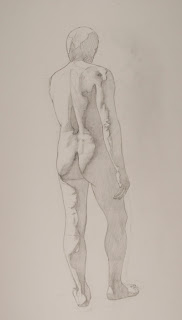 |
| Drawing |
"I usually spend 3-5 days on the drawing but with this pose I didn't have to worry about the models face, hands or feet, so the drawing only took 3 days. With the drawing, I move from the general to the specific, starting out with loose gestural shapes. Within the first 20 minutes I try to establish some approximate measurements and proportions: Height to width and halfway points. I also try to capture a gesture that I like, knowing that the model will inevitably move around a lot. I try to remember what initially inspired me about the pose and stick with that. With this pose I liked the sillouette of the figure as it twists up in to the light and how the light just catches the edge of the arm. At the beginning of the drawing processI focus on seeing the figure in flat, abtract shapes, keeping everything loose so that I can easily shift things and make changes. As I progress I hone in on the pelvis/ribcage relationship and begin thinking about these structures as three-dimensional objects, shifting in to a more sculptural frame of mind. My final drawing isn't very "pretty" but it is a clear record of the information I will need to complete the painting. I'd love to get better at making more beautiful drawings, so that is something I will keep working on in the future."
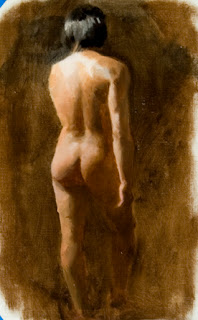 |
| Color Study |
"I spent days 4 and 5 on this small color study. I used a scrap of canvas, 5" x 7". In this stage I'm trying to map out the general color and value relationships. I don't worry too much about getting the drawing correct. Over the last few months I've been enjoying this stage of the process the most because it is so fun to be able to push the paint around, make quick decisions and move fast. The purpose of the color study is to serve as a guide during the final painting process, when it can be easy to lose sight of where you are going in the bigger picture. When I'm working on the final painting I sometimes mix my colors by matching them directly to the color study. Of course, I'm always looking at the model too, but the color study just helps me keep in mind the major themes that unite the entire picture. I try to establish a hierarchy of values, starting with the forms most facing the light and descending to the forms recieving the least amount of light. Within the hierarchy of values I'm also looking for shifts in chroma and hue. My palette consists of Cremnitz White, Cadmium Yellow Lemon, Yellow Ochre, Raw Umber, Capuccine Red Light, Cadmium Red Light, Burnt Sienna, Alizarin Crimson, Burnt Umber and Ivory Black. For a medium I use Oleogel from Natural Pigments. I'm always experimenting with which colors I like to use and each model has a different skin tone so the palette shifts from month to month."
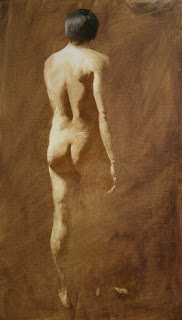 |
| Wipe Out |
"On day 6 I tranfer the drawing to a canvas that I've stretched at home. I like to use Claessens 13 double primed linen. It is a smooth portrait linen and not too absorbent. Getting the drawing transferred is always stressful because you inevitably lose some of the valuable information that you've worked so hard at recording during the drawing phase. I make a photocopy of the drawing, sometimes enlarging it by about 10-15%. Then I rub graphite on the back of the photocopy and trace over the lines to transfer the graphite to the canvas. There are two reasons why I use a photocopy instead of the original drawing. The first being that the photocopy is on very thin paper which makes the transfer more accurate. The second is that I will need the drawing in it's original state as a reference during the final painting stage. Because the transfer will inevitably be flawed, I need to keep looking back to the drawing to make sure that I stay faithful to it. I use a micron pen or a brush with India ink to trace the drawing onto the canvas again so that it is permanent. With this painting I decided to lay down a wash of burnt umber mixed with raw umber and then wipe out the highlights with a rag. I immediately regretted this move because it became very difficult to see the drawing underneath the wash. The wonderful thing about the GCA experience is that we have a controlled environment in the studio with the exact same conditions every month. It really takes repetition, along with trial and error to work through the variety of challenges that figure painting throws at you. Each month I am trying to keep the things that worked from last month and correct the things that I felt went wrong."
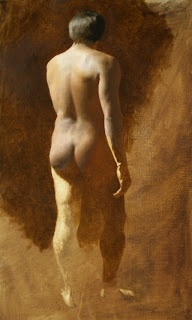 |
| Final Pass - Halfway Complete |
"During the final pass I am trying to paint each form to completion before moving on to the next section. It is tempting to move faster and skip around, telling myself that I'll return to the first part later and fix it, but the reality is that it's very hard to work back in to dry paint so it's better to get it right the first time. Another reason I try to paint this way is that it forces me to make more concious decisions and stay present in the moment. From my position in the room the light was skimming across the model's skin, creating some very confusing highlights. I really struggled to understand this light effect and spent a disproportionate amount of time on his upper back, where the highlights were most confusing."
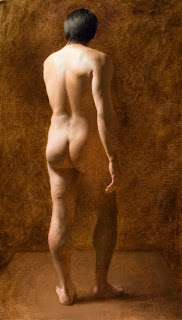 |
| Final Painting |
"In conclusion, I feel like I made some good progress with this painting. I was very happy with the color study and I had an easier time staying present on the form when I was painting the parts of the model that are in light. I am not so happy with how the entire picture looks as a whole. I would like to find a way to integrate the shadows more. These shadows seem very transparent and unfinished, like they weren't really considered during the painting process (I admit, they weren't given much consideration at all). Also, the background is entirely too hot and distracting. On my current paintings I've tried to remedy this by painting on a lighter background of transparent raw umber. It is a lot more neutral and so far I like it better. In general I felt like I am at a point where I am so focused on getting the individual parts of the figure right that I have not yet been able to integrate the entire picture in a harmonious way. That is what I am working on improving as I move forward."
"The practice of painting each form to the finish before moving on to the next one is very useful for training yourself to become efficient and accurate at 'getting on the form' and using the right color/value choices the first time around."






3 comments:
Thank you for sharing. This was very informative.
Thank you for sharing. This was very informative.
Wonderful post!
Post a Comment